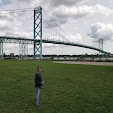It's not often that you hear about
the planned removal of a dam in an urban area, but that's exactly the kind of
project that the independent city of Lynchburg, VA has embarked on. The
city and the University of Lynchburg are nearing the midway point of a lengthy
project intended to reimagine the Blackwater Creek watershed in the area of the
nearby University, while also replacing a structurally-problematic earthen dam
and creating a newer, safer alignment for the local highway that currently
crosses it.
The existing College Lake Dam was built in 1934 and impounds
Blackwater Creek to form College Lake, which has a surface area of about 17 acres
along the western periphery of the University campus. The dam additionally serves
as the embankment that carries Lakeside Drive (US Route 221) across College
Lake and the Blackwater Creek. The dam itself was built of compacted clay and
stands 35 ft tall and is about 300 ft long. At the east end of the dam is a
spillway for Blackwater Creek that is bridged by a single-span concrete &
stone masonry arch. Severe flooding of College Lake due to record rainfall in
August 2018 overtopped the dam and nearly caused its collapse; this incident
prompted local and state officials to consider the dam’s removal as part of a
larger restoration of Blackwater Creek and updating of the Lakeside Drive
corridor.


Above: The College Lake Dam is an earthen embankment that impounds Blackwater Creek near the University of Lynchburg to form College Lake
Below: The new four-way roundabout intersection at the main entrance to the University nears substantial completion
With the City and University in agreement that the safety and ecology of the College Lake area needed to be addressed, the first step in the construction process (which began in 2021 and is not expected to wrap up until 2024) is the construction of a four-lane bypass bridge to carry Lakeside Drive across Blackwater Creek a short distance downstream (north) of the dam site. As part of the bridge project, a new four-way roundabout intersection is being constructed at the east end of the new bridge in order to better and more efficiently serve access to the University of Lynchburg’s main entrance. Upon completion of the bridge in Summer 2022, work will begin on the removal of the College Lake Dam and the restoration of the surrounding ecosystem and wetlands to what local officials hope will be pre-dam conditions. Local officials are optimistic that this urban wetland restoration effort (which has a price tag of about $18 million) will not only provide ecological uplift and water quality benefits for the Blackwater Creek watershed, but will additionally serve as a model for future urban wildlife restoration efforts to be considered by municipalities nationwide.
The following aerial pictures of the construction site (from June 2022) were taken
by the author of this post using a DJI quadcopter drone. Always use proper
judgment and situational awareness when flying in areas such as this. Click on
each photo to see a larger version.



























Comments